Art Fairs
‘We Sell for the Same Prices Here That We Sell at Basel’: Nigerian Collectors Hunt for West Africa’s Next Art Stars at Art X Lagos
The art fair closed its physical iteration on November 7.
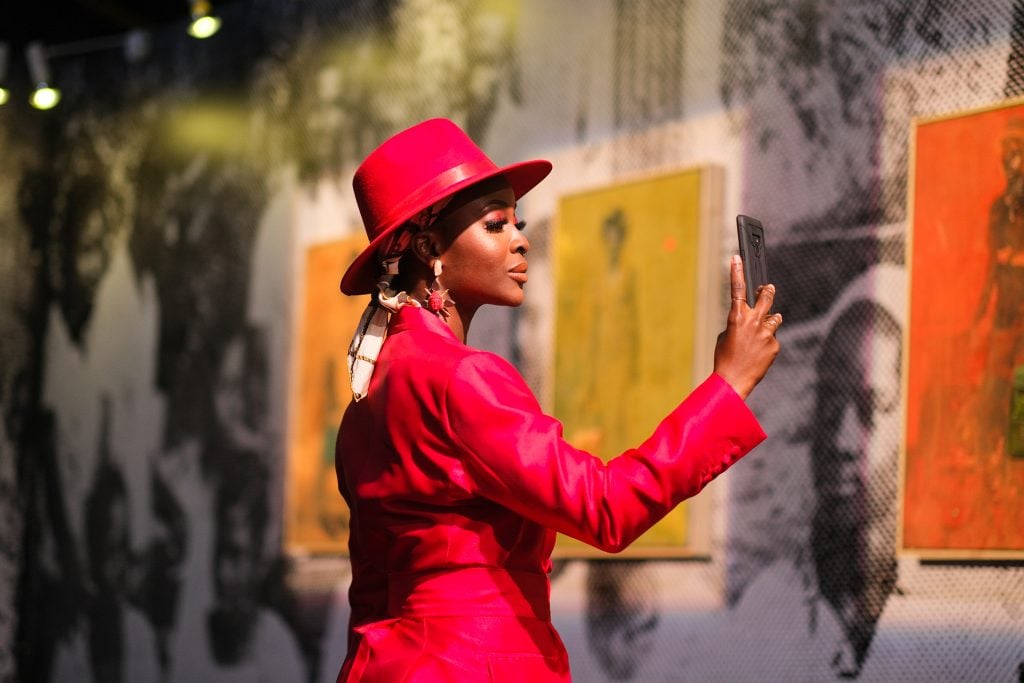
The art fair closed its physical iteration on November 7.

Rebecca Anne Proctor

As crowds of visitors entered the slickly-constructed white-tented fairground of the sixth edition of ART X Lagos on the Nigerian city’s Victoria Island, the first work they confronted was a painting by Amoako Boafo—the Ghanaian painter recently turned art world star—hanging on the outside wall of Accra and London-based Gallery 1957’s booth. On the fair’s VIP opening night, guests rushed to take pictures in front of the electrically-colored portrait titled Ultramarine Blue Belt (2021).
Despite the clamor surrounding the in-demand market star, the gallery claimed that the painting wasn’t for sale. They said that Boafo, whose startling portraits hold space for African self-determination and largely depict underrepresented or misrepresented members of the creative community, felt it was important to show his work in Lagos.
Nigeria’s exhilarating economic capital of more than 14 million people, which is also home to one of the largest pools of art collectors on the continent, is increasingly becoming a significant cultural hub. While Accra, the capital of Boafo’s neighboring home country, has witnessed an art boom in recent years, Lagos remains the leading Sub-Saharan African city for the sale of art and cultural production. This is largely thanks to its growing collector base, old and new art galleries, and institutions.
“I founded the fair to reflect the spirit of Lagos; I wanted to show to the world that my city is a remarkable place and that its people are dynamic and welcoming,” the fair’s director and founder Tokini Peterside told Artnet News. “Lagos, as Africa’s music capital, fashion capital and film capital, should also be Africa’s art capital. I want Lagos to welcome the rest of Africa here in this pan-African spirit that is incredibly important.”
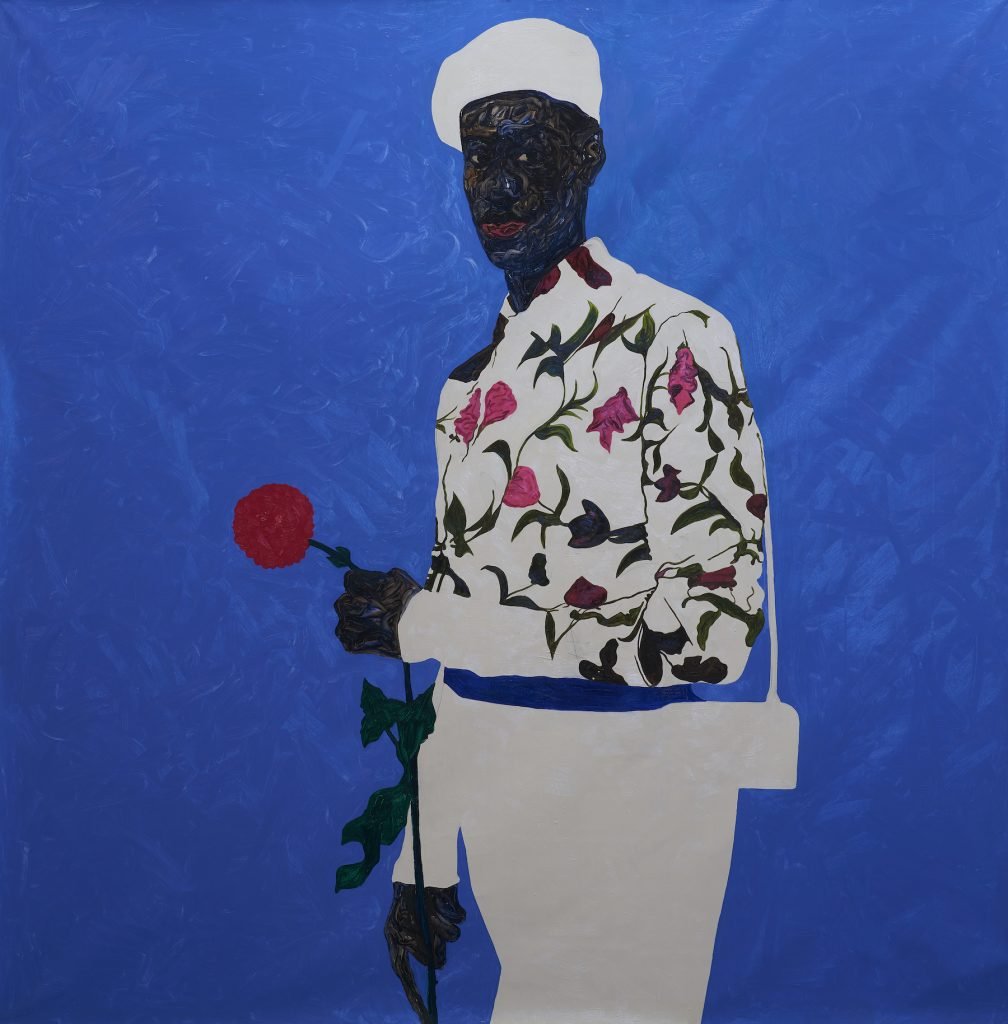
Amoako Boafo, Ultramarine Blue Belt (2021). Courtesy the artist and Gallery 1957.
While this year’s edition of the fair, which closed its physical iteration on November 7, was its largest ever in terms of participating galleries (there were 30 in total between its online and in-person showings), the physical fair welcomed just 15 galleries compared to the 23 that showed in its 2019 edition. Previous participants such as Paris-based Magnin-A decided not to attend in-person due to public health restrictions including a seven-day mandatory quarantine period—which was lifted ahead of the fair, but too late for dealers to rearrange their plans—but showed in ART X Lagos online, which runs until November 21. Also missing were some of Lagos’ biggest names, notably Retro Africa, which has participated in every fair since its launch in 2016 but decided to forgo this year’s edition as it focuses on expanding its global network.
Despite the backdrop of the public-health crisis and political challenges in Nigeria, the mood at the fair was upbeat and vibrant as a cohort of predominantly Nigerian collectors arrived en masse dressed in high fashion right down to their mandatory face masks. Prices hovered in the range of $10,000 and $30,000 and most artworks were paintings and photographic works except for a new section which highlighted the growing digital art scene on the continent in the NFT auction “Reloading,” staged in collaboration with NFT marketplace SuperRare.
While curious collectors eyed the NFTs eagerly, the overall zest was for buying works at the galleries present. One of the most expensive works sold was a large painting of Friends like Twins (2021) by sought after Ghanaian painter Kwesi Botchway for $60,000. Gallery 1957, which nearly sold out its booth, also presented new works on canvas by Adjei Tawiah, David Doku-Borlabi, Oliver Okolo, Patrick Eugène and Juwon Aderemi in the range of $10,000–$25,000.
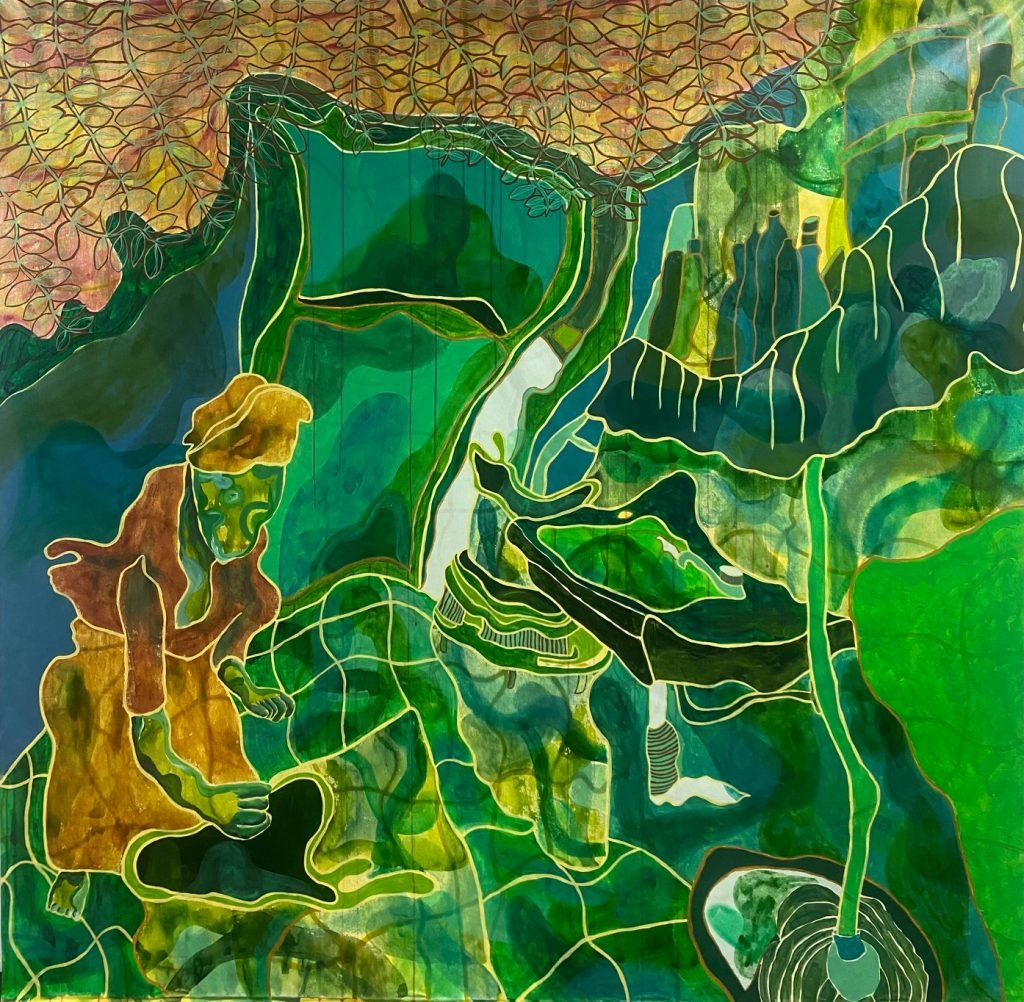
Araba Opoku, Kaashimi Crescent (2021). Courtesy Kó Gallery.
Amid the competition for the work on view, Peterside said that some guests were left disappointed when they learned many galleries had sold works ahead of the fair’s opening. The heated preview interest reflects the collecting hunger for identifying West Africa’s up-and-coming stars at home before they break out internationally.
One buzzed-about artist was the Ghanaian Araba Opoku, whose dreamy abstract paintings reference the challenges in Ghana over the lack of water. Opoku is the first recipient of the Yaa Asantewaa Art Prize for women staged by Gallery 1957, and two of her large paintings sold for $10,000 dollars each at Lagos-based kó Gallery, founded and directed by collector Kavita Chellaram, who is on Tate Modern’s African art acquisitions committee.
“Araba sold out instantly before the show,” Chellaram told Artnet News. “People are begging for more.”
Kó Gallery, which had two booths at the fair, also presented limited-edition prints by the late Nigerian modernist Yossi Grillo, which sold for between $6,000–$8,000. Grillo was a Zaria Rebel, proponent of an artistic philosophy in the fifties promoting Nigerian artistic identity against the Westernized expression in art education pre-Nigerian independence from Britain.
Elsewhere, Kampala-based Afriart Gallery, participating for the third time, showed works by Ugandan painter Henry Mzili Mujunga who depicts realistic scenes of everyday life in East Africa and who garnered much attention among eager collectors at the fair, and emerging Ugandan female artist Mona Taha, whose drawings in charcoal render poignant portraits of women. The gallery nearly sold out by the second day, selling Mujunga’s work in the range of $15,000–$25,000 and Taha’s for between $1,500 to $4,000. The gallery will show for the first time at Art Basel in Miami Beach next month.
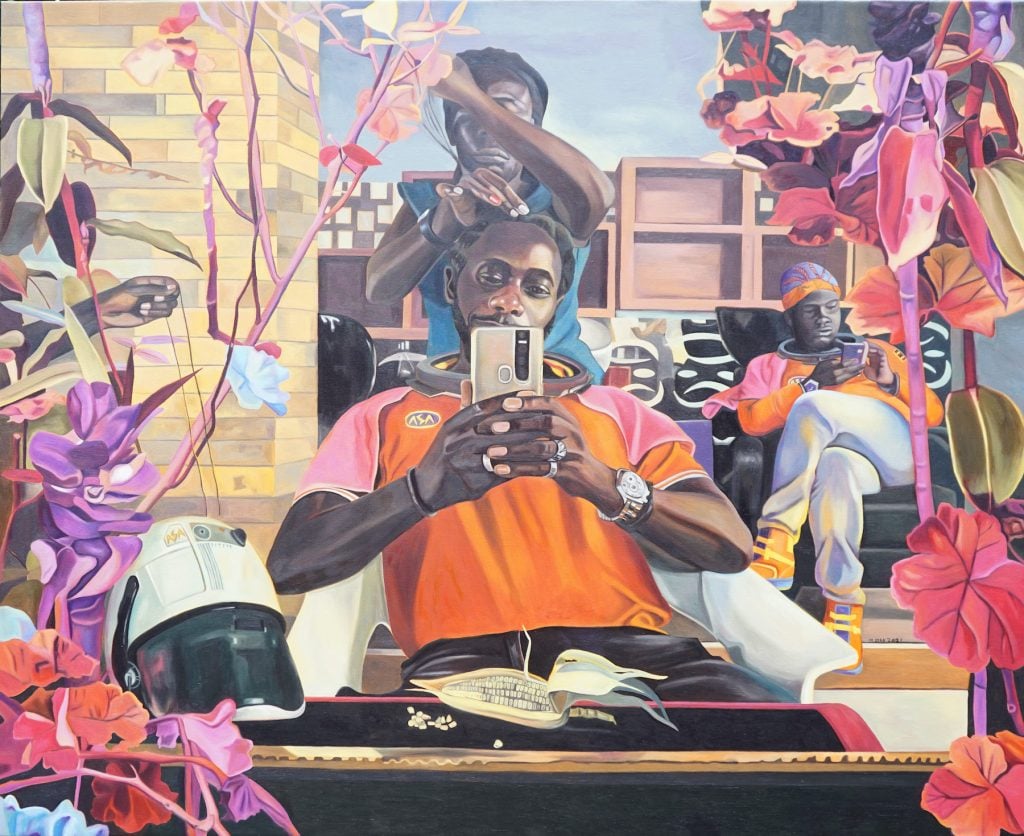
Henry Mzili Mujunga, Entanda (2021). Courtesy of Afriart Gallery.
The swift sales to predominantly Nigerian clients illustrated how many of the galleries at ART X Lagos come to tap into the Nigerian collector pool. “We had wanted to participate for many years,” said Nicole Louis-Sidney, of first time attendee Abidjan-based LouisSimone Gallery. “Nigeria is known for its collector base that we want to meet.” The gallery, which showed a range of works on canvas and a mixed media work by Ange Arthur Koua from Ivory Coast, reported much interest but no sales yet on the third day of the fair.
Some dealers stressed the importance of Lagos as a fair in Africa for Africans.
“Lagos is the only fair in the world that has an opening with 90 percent Black people in the audience,” Daudi Karungi, owner and founder of Afriart Gallery, said. And that audience is just as wealthy as those who flock to the major art fairs in the West. According to Bloomberg, in 2020 Nigeria topped South Africa as the continent’s largest economy due largely to an increase in oil output and the central bank’s move to boost credit growth. The West African nation has a thriving telecoms, banking, oil and gas sectors that has resulted in a growing middle class, which accounts for around 23 percent of the population and has a buying power in excess of $28 billion, according to Persianas.
“Nobody comes to Lagos for discount works,” Karungi said. “Galleries don’t say ‘we are coming to Africa to sell it cheaper’ here. We sell for the same prices here that we sell at Basel.”
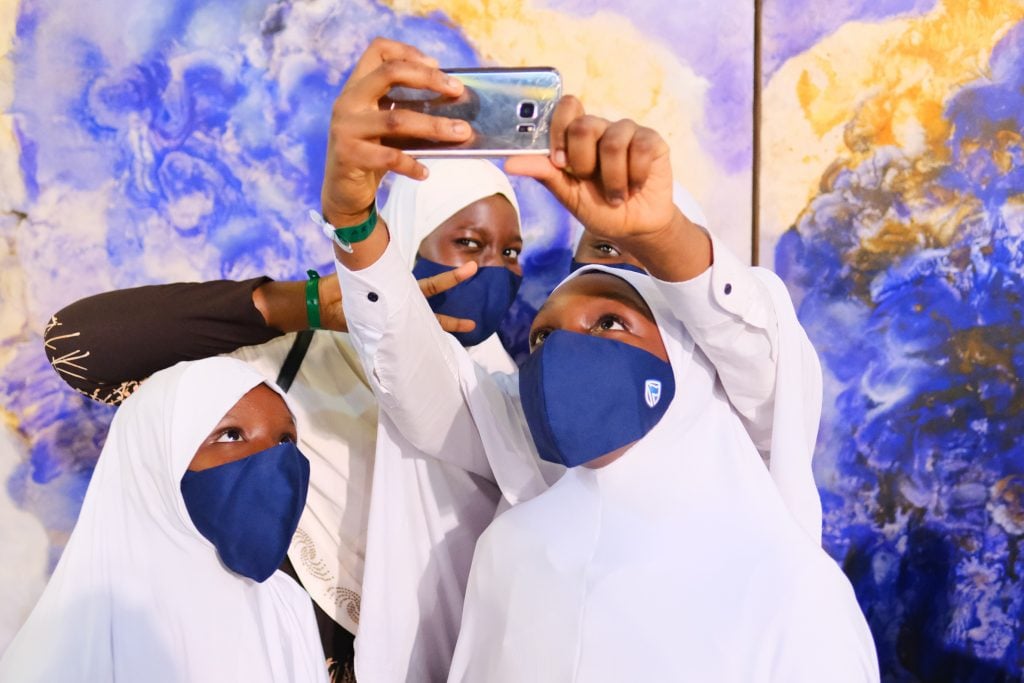
Guests interacting with art at Galerie MAM booth. Courtesy ART X Lagos.
And the fair is encouraging a younger generation of established Nigerians to buy and invest in art. “I’ve run into many of my friends at the fair and I’ve asked them if they are collectors and they say they aren’t but are just starting to buy,” Nigerian American Reni Somoye, of Art X Lagos, told Artnet News. “They are in their thirties and recognize now that art is a way to invest, park and grow your money, and participate in your culture in a way that a lot of people my age haven’t previously done.”
Several collectors remarked that, until recently, it was a struggle to bring Africa to the global stage. Long existing art scenes in West Africa and throughout the continent have only over the last 10 years garnered long overdue attention from the international art scene. Events like ART X Lagos have been principal in changing the game.
“I think now the global stage has warmed up to African art,” Nigerian collector Frank Momoh, who has been collecting for 20 years, told Artnet News. “Art X is a fantastic platform to showcase what we have, our cultural heritage and our style and it has turned into a global phenomenon… It’s improved the world’s perception of what Africa has to offer in terms of art.”